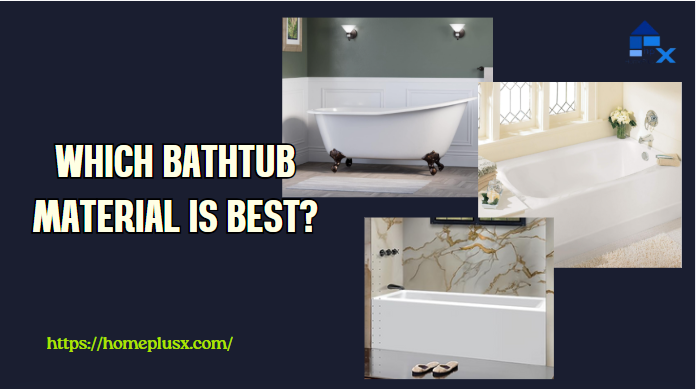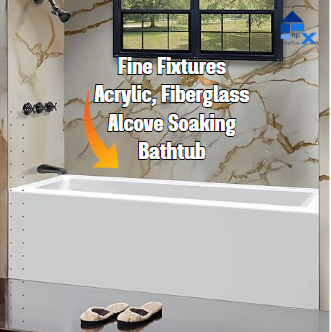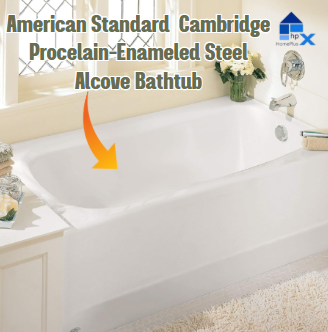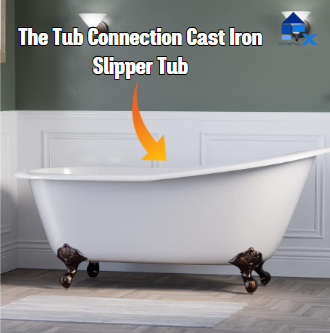
Planning to buy a bathtub? But not sure which bathtub material is best?
Then, this guide on “which bathtub material is best “can help you a lot.
Choosing the best bathtub based on material is not an easy task. You won’t find everything in one tub. So you have to prioritize your desires.
When selecting the best tub material, it’s wise to put the following aspects in priority order:
- affordable
- resistant to chips, crack and mildew
- easy to clean and maintain
- longevity of finish
- retains heat well
- lightweight and luxurious aesthetic
For all of these factors, it’s essential to consider the positives and negatives for each of the most common bathtub materials.
In this guide, I’ll cover the pros and cons of each of the most popular bathtub materials. By the end, you’ll be armed with the information on the best material choice possible for your home.
Let’s look at some of the different material choices and try to clear up a bit of the confusion.
Are you ready?
Don’t miss to check out on the comparison chart for each type of material.
Table of Contents
Which Are the Common Materials Used in Bathtubs?
Many different material choices are available when it comes to bathtubs.
5 most common materials used in bathtubs are:
- Fiberglass
- Porcelain over steel
- Acrylic
- Cast iron
- Ceramic
The material you select for your tub affects its weight, heat retention, durability, ease of maintenance, appearance, feel and, of course, price. Each comes with its pros and cons.
Bathtubs are not easy to replace, so the materials the bathtub is made of are a significant factor in your long-term investment.
5 Most Common Bathtub Materials- The Pros and Cons of Each
I’ve been trying to figure out and compare all the different aspects (advantages and drawbacks) I’ve found in different kinds of materials that bathtubs can be made of.
Let’s take a look!
I Hope, this discussion helps you a lot to find the best quality bathtubs for your need
1. Fiberglass

This is one of the most common and popular materials used for making bathtubs.
Do you think that it is glass?
NO…..Fiberglass is a particular type of reinforced plastic. It is formed into many layers of the same properties.
✅ Pros
Low price- One of the most significant advantages that come with fiberglass bathtubs is their affordable price. Notably, these types of tubs are less expensive than acrylic.
Lightweight- Fiberglass is a lightweight material. Due to this nature, fiberglass tubs are easy to maneuver during installation.
Chip-resistant & easy to repair- These tubs don’t chip easily. What’s more, you can easily fix any damage.
Cons
Porous- Due to the porous nature of fiberglass, this fixture tends to absorb water which can lead to cracking and discoloration.
Not as durable as other materials – Fiberglass is brittle in nature. So, they are prone to cracking.
Deteriorate over time– This material doesn’t stand up well. It is most likely dull and changes color due to the use of common bathtub cleaning equipment. Fortunately, many fiberglass repair kits can take care of these problems.
Not stable– they flex so that you won’t get a stable feeling.
Should I buy a fiberglass bathtub?
If you’re looking for a cheap option, a fiberglass bathtub will suit your budget. Fine Fixtures BTA104-R is one of the best fiberglass alcove soaking bathtubs.
2. Porcelain over Steel/ Enameled Steel
This is another very common material for a bathtub. The construction features stamped steel or cast iron coated with porcelain enamel. No worry! The coating is durable and resists the most common chemicals.
✅ Pros
Glossy appearance- Porcelain bathtubs feature very smooth surfaces that maintain a very nice sheen and luster. Its appearance holds a conventional appeal. What’s more, the surface retains an excellent look for many years.
Highly resistant to scratching – This material is naturally resistant to chipping and scratching, not to mention that it is easy to clean.
Easy to maintain- You can easily knock out any tough stains with warm water and simple baking soda or mild detergent.
Very durable- You will love the fact that an enameled steel tub serves you for many years.
Relatively lightweight- Porcelain-enameled steel tubs are lighter in weight than old-fashioned enameled cast iron tubs. On the other hand, they are somewhat heavier than fiberglass or acrylic.
❌ Cons
Not impact-resistant– Under the right amount of impact, chipping or even shattering may both occur easily.
Quite slippery- Porcelain tubs are pretty slippery.
Not good for heat retention– Porcelain loses heat quickly. So your bathwater doesn’t stay hot for all that long.
So, should I go for a porcelain tub?
If you already have a fiberglass or acrylic tub that needs to be replaced, I would recommend going for a porcelain tub.
Wondering why?
Firstly, it’ll fit nicely in the same opening of 5 ft.
Secondly, you can finish the tub perfectly by surrounding it with ceramic tiles.
3. Acrylic

Technically, acrylic is a specific type of vacuum-formed acrylic sheet that is reinforced with fiberglass. Let’s find out the acrylic bathtub’s pros and cons.
✅ Pros
Lower risk of chipping and cracking- Acrylic tubs are non-porous. The advantage of these properties is tubs made with acrylic don’t absorb water. This makes the coating long-lasting and resistant to chipping and cracking.
Requires minimal maintenance- Acrylic bathtubs are easy to maintain, repair, and install.
Durable and have a long lifespan- Acrylic stays glossy and stands up to frequent use and extensive cleaning.
Resistant to the buildup of mildew- Acrylic is excellent at repelling any mildew and general bathroom stains.
Great for heat retention- This material is excellent at retaining heat. So your bath water will stay hot for quite some time.
Many options to choose from- Acrylic bathtubs are available in different colors, shapes, and sizes. So, you may get spoiled with choices.
❌ Cons
Susceptible to scratches and discolor– the finish becomes dull and scratches easily though not to the quality of fiberglass. Fortunately, advanced technology helps a lot to reduce this problem to zero and have better finishes.
Not Stable- Acrylic flexes which may make you feel slightly unstable while standing on it. It is recommended to reinforce the stress point during installation properly.
Not a very cheap option – this type of bathtub cost more in terms of the ones we have looked at so far. You have to pay upwards of eight hundred to a thousand starts.
So, should I go for an acrylic tub?
If you want a lightweight, long-lasting and affordable bathtub, acrylic can be a good option for you. You also have the options to choose from different colors and styles.
American Standard 2460002.020 Cambridge is one of the best porcelain-enameled steel alcove bathtubs.
4. Cast iron

It is a classic material for a bathtub. The construction features molded iron with porcelain enamel.
✅ Pros
Very durable- It is a high-end option that will really last.
Chipping and scratch-resistant- This material makes the tub resistant to chipping and scratching.
Easy to care- Speaking of cleaning, it requires less care. You can clean the cast-iron bathtub with just plain warm water and baking soda. For deep cleaning, you can use a light cleaning agent such as Comet.
Excellent heat retention- Due to high heat retention properties, So, it keeps your tub water warm for a long time.
Many color choices available- This material comes in a variety of colors.
❌ Cons
Very heavy- The serious disadvantage of this material is its weight. Heavyweight complicates the installation process.
Difficult to install- Due to its weight, it can be pretty tricky to install. Moreover, it may require additional supports or structural reinforcement on the floor.
So, should I go for a cast iron tub?
If you’re looking for a tub that has greater heat retention for keeping your bath water warm for a long time, I suggest going for a tub made of cast iron.
The Tub Connection 67″ is one of the best Cast Iron Slipper Tubs.
5. Ceramic
Ceramic bathtubs are made with numerous tiles of ceramic.
✅ Pros
Design variety– These tubs have the most options for shape, size, and color.
Fairly cheap- Depending on the quality of tiles, these bathtubs come at different affordable prices.
❌ Cons
Not easy to maintain- It requires extra maintenance.
Irregular surface– Due to the makeup of ceramic, the surface of the bathtub feels uneven, which may be uncomfortable against your bare skin or to lay in.
Bathtub Material Comparison
Here’s a quick comparison of the 5 most common bathtub materials to help you see how they stack up:
| Material | Price | Durability | Weight | Heat Retention | Maintenance | Appearance |
|---|---|---|---|---|---|---|
| Fiberglass | Low | Low | Very light | Poor | Easy, but needs frequent repair | Basic, can fade over time |
| Porcelain over Steel | Moderate | Good (scratch-resistant) | Light to moderate | Poor | Easy | Glossy and classic |
| Acrylic | Moderate to High | Good (long-lasting) | Light | Good | Very easy | Glossy, many colors |
| Cast Iron | High | Excellent | Very heavy | Excellent | Easy | Premium, timeless |
| Ceramic Tile | Varies | Fair (depends on tile quality) | Heavy | Fair | Difficult | Most customizable |
Summary:
Budget-conscious? Go for fiberglass or ceramic.
Want long heat retention? Cast iron is unbeatable.
Looking for easy maintenance and variety? Acrylic is a great middle ground.
Prefer a solid feel with classic looks? Porcelain over steel delivers.
Craving custom design? Ceramic gives you endless creative options, but be ready for the upkeep.
So, Which Bathtub Material Is Best?
Well, I can’t say it’s exactly.
But you’ll agree with me that the best tub material is one that makes the tub durable, resistant to mold and mildew, retains heat well, and is easy to clean.
All of the above, it must meet your budget and desired aesthetic.
Thanks for reading!
FAQs
What type of bathtub material is best for my bathroom?
First, you have to prioritize your desires. If you’re looking for an easy-to-clean, lightweight, and inexpensive tub, fiberglass is the best option for you.
Wood and Porcelain-enameled steel bathtub are best if you want extreme heat retention.
A porcelain-enameled cast iron tub is the best option if you’re in search of a quiet sound while filling.
So, the choice is yours.
Which one is the best bathtub material for the environment?
The honorable mention goes for stone resin. It is made of 100% recycled materials, and the manufacturing process is also eco-friendly. Stone resin bathtubs are lighter than stone bathtubs.
What is the best bathtub material for heat retention?
Although many materials retain heat well, all of them don’t work the same way.
When empty, porcelain-enameled, cast iron bathtub feels cool to touch. But when you fill it with water, it slowly gets warm and retains heat for a long time.
Wood bathtubs also retain heat well.
Bathtub construction also affects its heat retention. Porcelain-enameled steel, copper, and acrylic tubs come single or double-walled. A double-walled tub does a better job of heat retention than a single-walled tub.

Certified Pool & Spa Maintenance Specialist (CMS)
Patrick Martinez is a pool and hot tub professional. He is a Certified Pool & Spa Maintenance Specialist (CMS). He has a strong understanding of patio, spa, pool safety, maintenance, and water chemistry. (See Full Bio)